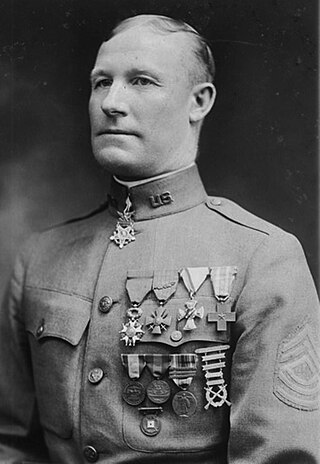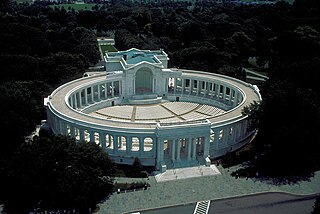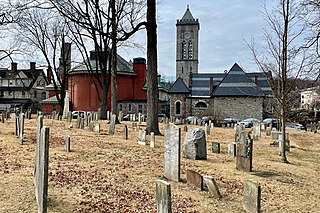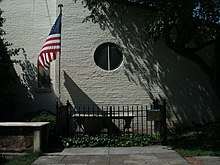
A Tomb of the Unknown Soldier or Tomb of the Unknown Warrior is a monument dedicated to the services of an unknown soldier and to the common memories of all soldiers killed in war. Such tombs are located in many nations and are usually high-profile national monuments. Throughout history, many soldiers have died in war with their remains being unidentified. Following World War I, a movement arose to commemorate these soldiers with a single tomb, containing the body of one such unidentified soldier.

The Tomb of the Unknown Soldier is a historic funerary monument dedicated to deceased U.S. service members whose remains have not been identified. It is located in Arlington National Cemetery in Virginia, United States. The World War I "Unknown" is a recipient of the Medal of Honor, the Victoria Cross, and several other foreign nations' highest service awards. The U.S. Unknowns who were interred are also recipients of the Medal of Honor, presented by U.S. presidents who presided over their funerals. The monument has no officially designated name.

Arlington National Cemetery is one of two cemeteries in the United States National Cemetery System that are maintained by the United States Army. Nearly 400,000 people are buried in its 639 acres in Arlington County, Virginia.

The parish of Trinity Church has three separate burial grounds associated with it in the New York City borough of Manhattan. The first, Trinity Churchyard, is located in Lower Manhattan at 74 Trinity Place, near Wall Street and Broadway. Alexander Hamilton and his wife Elizabeth Schuyler Hamilton, Albert Gallatin, and Robert Fulton are buried in the downtown Trinity Churchyard.

The Tomb of the Unknown Soldier is a tomb situated before the National War Memorial in Confederation Square, Ottawa, Ontario. The tomb is dedicated to Canadian service members, and holds the remains of an unidentified Canadian soldier who died in France during the First World War; selected from a Commonwealth War Grave near Vimy, in the vicinity where the Battle of Vimy Ridge took place. A similar memorial was installed in June of 2024 at the National War Memorial in St. John's, Newfoundland to contain the unidentified Great War remains of a soldier of the Royal Newfoundland Regiment.

An eternal flame is a flame, lamp or torch that burns for an indefinite time. Most eternal flames are ignited and tended intentionally, but some are natural phenomena caused by natural gas leaks, peat fires and coal seam fires, all of which can be initially ignited by lightning, piezoelectricity or human activity, some of which have burned for hundreds or thousands of years.

Washington Square, originally designated in 1682 as Southeast Square, is a 6.4 acres (2.6 ha) open-space park in Center City, Philadelphia, The southeast quadrant and one of the five original planned squares laid out on the city grid by William Penn's surveyor, Thomas Holme. It is part of both the Washington Square West and Society Hill neighborhoods. In 2005, the National Park Service took over ownership and management of Washington Square, through an easement from the City of Philadelphia. It is now part of Independence National Historical Park.

A war grave is a burial place for members of the armed forces or civilians who died during military campaigns or operations.

Samuel Woodfill was a major in the United States Army. He was a veteran of the Philippine–American War, World War I, and World War II. Woodfill was one of the most celebrated American soldiers of the early 20th century. General John Pershing called Woodfill the most outstanding soldier in World War I. During an offensive in October 1918, he single-handedly neutralized three German machine gun emplacements while suffering under the effect of mustard gas, and was able to successfully lead his men safely back to the American lines without casualties. Woodfill was considered to be one of America's most decorated soldiers in World War I. He received the Medal of Honor, the French Légion d'honneur in the degree of Chevalier, the French Croix de guerre with bronze palm, the Montenegrin Order of Prince Danilo I in the degree of Knight and the Italian Croce al Merito di Guerra among other awards. So legendary was Woodfill's renown, that almost 11 years after the war ended, a Polish Army delegation presented him two medals. The presentation occurred during the 11th Annual National Convention of the American Legion held in Louisville, Kentucky from 30 September - 3 October 1929.

Memorial Amphitheater is an outdoor amphitheater, exhibit hall, and nonsectarian chapel located in Arlington National Cemetery in Arlington County, Virginia, in the United States. It was designed in 1913 as a replacement for the older, wooden amphitheater near Arlington House. Ground was broken for its construction in March 1915 and it was dedicated in May 1920. In the center of its eastern steps is the Tomb of the Unknown Soldier, dedicated in 1921. It has served as the site for numerous Veterans Day and Memorial Day events, as well as for memorial services and funerals for many individuals.

The Tomb of the Unknown Revolutionary War Soldier, also known as the Tomb of the Unknown Soldier of the American Revolution, is a war memorial located within Washington Square in Philadelphia, Pennsylvania. The memorial honors the thousands of soldiers who died during the American Revolutionary War, many of whom were buried in mass graves in the square. The tomb and Washington Square are part of Independence National Historical Park.

The First Presbyterian Church Cemetery is a historic churchyard cemetery of the First Presbyterian Church in Morristown, New Jersey, United States. The cemetery was added to the National Register of Historic Places, listed as a contributing property to the Morristown District, on October 30, 1973.

The Unknown Warrior is an unidentified member of the British Imperial armed forces who died on the western front during the First World War. He is interred in a grave at Westminster Abbey, also known as the Tomb of the Unknown Warrior.

The Old Presbyterian Meeting House is a Christian church located at 321 South Fairfax Street in the Old Town neighborhood of Alexandria, Virginia. It is part of the National Capital Presbytery and the Synod of the Mid-Atlantic of the Presbyterian Church (USA).

In the United States, state funerals are the official funerary rites conducted by the federal government in the nation's capital, Washington, D.C., that are offered to a sitting or former president, a president-elect, high government officials and other civilians who have rendered distinguished service to the nation. Administered by the Military District of Washington (MDW), a command unit of the Joint Force Headquarters National Capital Region, state funerals are greatly influenced by protocol, steeped in tradition, and rich in history. However, the overall planning as well as the decision to hold a state funeral, is largely determined by a president and their family.

St. Peter's Church in the Great Valley is a historic Episcopal church in East Whiteland Township, Pennsylvania, a Philadelphia suburb. The church was founded in 1704 as a missionary parish of the Church of England in what was then the colonial Province of Pennsylvania. The parish is part of the Episcopal Diocese of Pennsylvania.

Sugar houses in New York City were used as prisons by occupying British forces during the American Revolutionary War. Out of 2,600 prisoners of war captured during the Battle of Fort Washington in November 1776, 1,900 would die in the following months at makeshift prisons throughout the city. At least 17,500 are estimated to have perished under substandard conditions of such sugar houses and British prison ships over the course of the war, more than double the number of killed from battle.

The English coastal city of Brighton and Hove, made up of the formerly separate Boroughs of Brighton and Hove in East Sussex, has a wide range of cemeteries throughout its urban area. Many were established in the mid-19th century, a time in which the Victorian "cult of death" encouraged extravagant, expensive memorials set in carefully cultivated landscapes which were even recommended as tourist attractions. Some of the largest, such as the Extra Mural Cemetery and the Brighton and Preston Cemetery, were set in particularly impressive natural landscapes. Brighton and Hove City Council, the local authority responsible for public services in the city, manages seven cemeteries, one of which also has the city's main crematorium. An eighth cemetery and a second crematorium are owned by a private company. Many cemeteries are full and no longer accept new burials. The council maintains administrative offices and a mortuary at the Woodvale Cemetery, and employs a coroner and support staff.

The Maryland 400 were members of the 1st Maryland Regiment who repeatedly charged a numerically superior British force during the Battle of Long Island during the Revolutionary War, sustaining heavy casualties, but allowing General Washington to successfully evacuate the bulk of his troops to Manhattan. This action is commemorated in Maryland's nickname, the "Old Line State." A monument in Brooklyn and multiple plaques were put up in the memory of this regiment and the fallen soldiers.



















